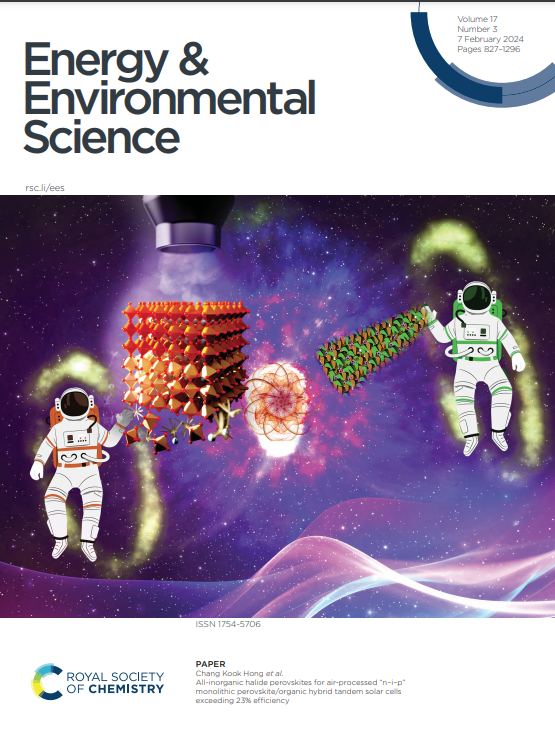实现高能量密度电池负极锂密度高于纯金属锂密度
IF 32.4
1区 材料科学
Q1 CHEMISTRY, MULTIDISCIPLINARY
引用次数: 0
摘要
阳极的低密度、高孔隙率锂(Li)电镀层是决定可充电高能量密度锂金属电池整体体积膨胀的主要因素之一,也是导致电池性能下降的重要原因。在本研究中,我们通过形成具有尾状成分和致密锂沉积结构的高锂密度固溶体,阐明了阳极的锂致密化,代表了低膨胀锂金属阳极的另一种概念。具体来说,我们发现,与块状金属锂相比,锂/银原子比在 12/1 至 18/1 之间的锂银固溶体具有更高的体积锂密度(指体积锂存储能力)。可以精心设计带有特定厚度银上层的锂金属阳极,以便在电池充电过程中从含锂阴极吸收活性锂后产生这种高锂密度的锂银固溶体,从而抑制电池的整体体积变化。令人印象深刻的是,50 μm 厚的锂/银阳极在 1 mA cm-2 和 4 mAh cm-2 的条件下循环 50 次后,体积膨胀极小,仅为 11%。这明显低于纯锂阳极的膨胀率,纯锂阳极的膨胀率超过 220%。值得注意的是,采用超薄锂/银阳极(40 μm)和 LiNi0.6Co0.2Mn0.2O2 (NCM622, 4.1 mAh cm-2)阴极组装的 Ah 级锂金属袋电池(约 421 Wh kg-1)在苛刻条件下的寿命超过了 320 次循环,负/正容量(N/P)比为 1.95,电解质/容量(E/C)比为 1.71 g Ah-1。本文章由计算机程序翻译,如有差异,请以英文原文为准。
Achieving a higher lithium density in anode surpassing that of pure metallic lithium for high-energy-density batteries
The low-density, high-porosity lithium (Li) plating layer at the anode is one of the principal determinants of the overall volumetric expansion in rechargeable high-energy-density Li metal batteries, which account for a significant cause of battery performance degradation. In this study, we elucidated the Li densification at the anode through the formation of a high-Li-density solid solution with tailed components and dense Li deposit structure, representing an alternative concept for the low-expansion Li metal anode. Specifically, we revealed a Li-Ag solid solution with a Li/Ag atomic ratio ranging from 12/1 to 18/1 demonstrated a significantly higher volumetric Li density, referring to the volumetric Li storage capability, compared to bulk metallic Li. A Li metal anode with a specific-thickness Ag upper layer could be elaborately designed to produce such a high-Li-density Li-Ag solid solution after intake of active Li from the Li-containing cathodes during the battery charge process, suppressing the overall volume change of the cell. Impressively, a 50 μm-thick Li/Ag anode demonstrated minimal volume expansion of only 11% after 50 cycles at 1 mA cm−2 and 4 mAh cm−2. This is significantly lower than the expansion observed in its counterpart with pure Li, which exceeded 220%. Remarkably, Ah-class Li metal pouch cell (~421 Wh kg−1), assembled with the ultrathin Li/Ag anode (40 μm) and LiNi0.6Co0.2Mn0.2O2 (NCM622, 4.1 mAh cm−2) cathode, demonstrated a lifespan exceeding 320 cycles under harsh conditions with a low negative/positive capacity (N/P) ratio of 1.95 and electrolyte/capacity (E/C) ratio of 1.71 g Ah−1.
求助全文
通过发布文献求助,成功后即可免费获取论文全文。
去求助
来源期刊

Energy & Environmental Science
化学-工程:化工
CiteScore
50.50
自引率
2.20%
发文量
349
审稿时长
2.2 months
期刊介绍:
Energy & Environmental Science, a peer-reviewed scientific journal, publishes original research and review articles covering interdisciplinary topics in the (bio)chemical and (bio)physical sciences, as well as chemical engineering disciplines. Published monthly by the Royal Society of Chemistry (RSC), a not-for-profit publisher, Energy & Environmental Science is recognized as a leading journal. It boasts an impressive impact factor of 8.500 as of 2009, ranking 8th among 140 journals in the category "Chemistry, Multidisciplinary," second among 71 journals in "Energy & Fuels," second among 128 journals in "Engineering, Chemical," and first among 181 scientific journals in "Environmental Sciences."
Energy & Environmental Science publishes various types of articles, including Research Papers (original scientific work), Review Articles, Perspectives, and Minireviews (feature review-type articles of broad interest), Communications (original scientific work of an urgent nature), Opinions (personal, often speculative viewpoints or hypotheses on current topics), and Analysis Articles (in-depth examination of energy-related issues).
 求助内容:
求助内容: 应助结果提醒方式:
应助结果提醒方式:


